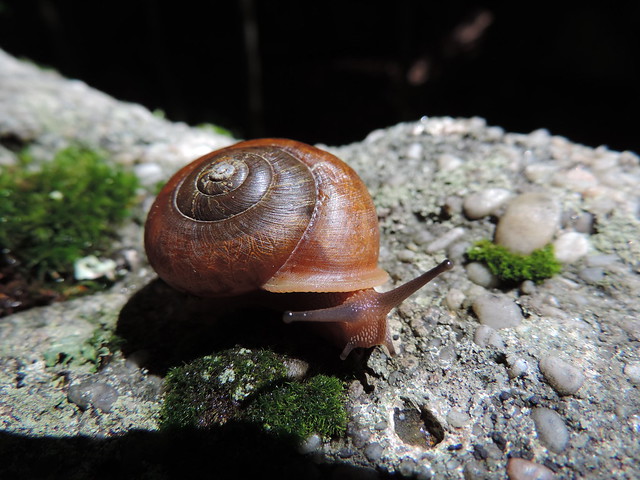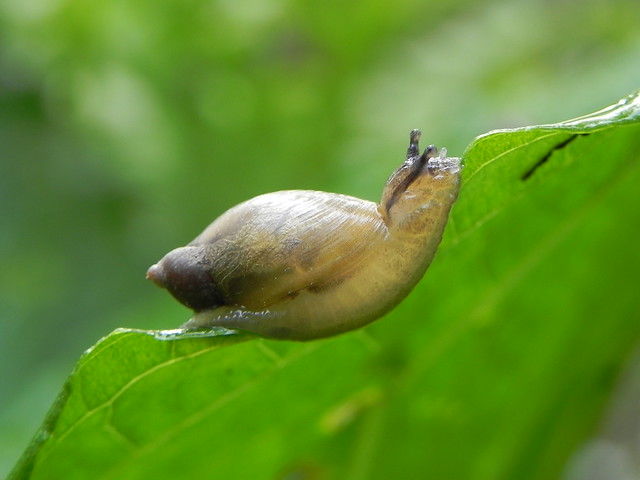Of all the flora and fauna in the region, snails are not one I think about very often. On hikes, they fall into the “just” category. Oh, it’s just a snail. Oh, it’s just a crow. Oh, it’s just a dandelion. They are so easy to overlook because they appear commonplace. Ordinary. Mundane.

But there are other ways to look at them. One way is through the lens of a child’s innate curiosity. It hardly ever fails, that these shelled creatures are picked up, carried about, and admired by kids. Snails are easy to spot and easy to catch. They move, but slowly. For kids, especially those just beginning to develop a hands on relationship with the natural world, they don’t startle or scare them. They are not sharp, stinging or stinking. Just slightly slimy.
But what do I really know about them? I know a soft bodied animal with a shell is a snail and one without is a slug. I’ve seen their small clutch of pea-like eggs under rocks and logs. I have caught them in a net in the pond.
Another way to look at them is through the finely tuned, captive eyes of artists and scientists. In her intriguingly titled book, The Sound of A Wild Snail Eating, Elisabeth Tova Bailey writes of her close observations of a woodland snail while she is ill and bedridden. She weaves the rich body of scientific knowledge of snails with her methodical examination and her ponderings to reveal the fascinating workings of these overlooked creatures. For more graceful words, read Bailey’s short book. For now, here are a few fascinating facts.
Snails belong to the unsegmented, soft-bodied group of animals called mollusks, which also include octopuses, squids and clams. Further classified, they are a gastropod, a group that includes snails and slugs. There are tens of thousands of snails identified in the three main areas on our planet – salt water, fresh water, and land.
With so many different species, in many different habitats, there is variability in how they survive. One way this is exhibited is in what they eat. Some are herbivores, eating leaves or algae off rocks. Others eat mushrooms, even consuming species of fungus known to be poisonous to humans. Others are scavengers, eating dead plant and animal material, providing the important service of recycling nutrients back to the soil. Other still are carnivores, even cannibals, eating other snails. This hits home as I look at shells I collected on the beach, all strung up via a string passing through small holes in the shell. This was the work not of a human drill but of the drill-like mouthpart of the ocean dwelling, predatory Moon Snail who fed on these snails and clams before their empty shells washed up on the beach.

Whatever they eat, they all eat the same way. The word “gastropod” comes from the Greek and Latin meaning, stomach foot. On the bottom of their large, muscular foot, snails have a mouthpart called a radula. This ribbon-like tongue is covered in over one thousand teeth that scrape and grind at their food. While these can only be seen under a microscope, I found it easy to imagine this toothed tongue as I closely watched the up and down nodding of the head of a snail eating an apple. And when the front teeth are worn, they are replaced with more from the back.
If you hold a snail in your hand, you may see its slimy body slowly come out of hiding from its shell. Two sets of tentacles emerge, one held higher and the other lower. Kids seem to know that snails carry their eyes on the ends of the higher tentacles. But snails don’t get the same visual image of the world through their eyes that humans do. Their eyes see mainly light and dark. Vision is not the most important sense in the snail world. Neither is sound.
Describing what that means in comparison to humans, Bailey writes about her woodland snail that it “… could not see the moss over which it glided or even the plants it climbed. It could not see the trees nor the stars overhead. It could not hear a bird song at daybreak nor the midnight howls of coyotes.”
Snails “see” the world mostly through smell but also taste and touch. And they receive most of this sensory information through the tentacles. These body parts are so critical to their survival, they can regrow if damaged.
Touch a snail and you can’t help notice the cool, slick, sticky body. Slime is another part critical to survival. Slime protects snails from drying out, provides it a roadway in which to slide, and glue to hold its body to the side and underside of most anything it desires. If injured, a snail can even secrete healing slime to repair its body and its shell. When analyzed, scientists have found that this slime is not an all-purpose slime. For each purpose, snails produce a chemically different kind of slime.
With the exception of a few species, snails are neither male nor female. They are capable of producing eggs and sperm and can self-fertilize if they needed to. Though many mate with another snail. Because of their slow movements and mainly solitary life the chances of meeting a mate are limited. So, when they do meet a mate, being flexible with their gender is an advantage. It makes me wonder how they choose who’s what when they need to.
Sometimes you make discoveries all on your own. Sometimes you need a guide. And it is through the wisdom of both kids, scientists, and artists, as well as the natural world, that I have found snails to be more than just commonplace. I don’t think I will just see a snail again.
Audubon Community Nature Center builds and nurtures connections between people and nature. ACNC is located just east of Route 62 between Warren and Jamestown. The trails are open from dawn to dusk as is Liberty, the Bald Eagle. The Nature Center is open from 10 a.m. until 4:30 p.m. daily except Sunday when it opens at 1 p.m. More information can be found online at auduboncnc.org or by calling (716) 569-2345.


Recent Comments